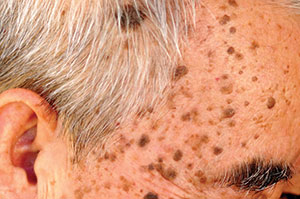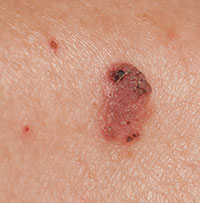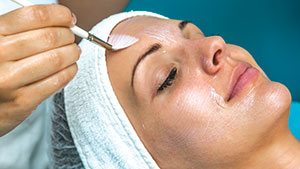Better Together: Working with Dermatologists to Heal Hyperpigmentation
Written by Craig A. Kraffert, MDFrom moles to melasma, there are various forms of hyperpigmentation for which clients seek treatment. Some are treated best under the care of an aesthetician; others require a dermatologist. And, sometimes, the two working together can lead to the greatest healing. Knowing the difference in these cases is vital.
 Requests for treatment of brown spots and irregular hyperpigmentation occur daily in skin care practices. To best serve these requests, a working knowledge of the spectrum of skin conditions that cause brown spots and hyperpigmentation, along with the array of treatment options for each condition, is vital for skin care professionals. Certain brown spots and pigmented areas respond well to interventions within the spectrum of an aesthetician’s services; others do best with a more invasive medical approach. Many real-world clinical situations with brown spots and irregular pigmentation fare best with a combination of an aesthetician’s and a dermatologist’s services in tandem, ideally as part of an organized plan.
Requests for treatment of brown spots and irregular hyperpigmentation occur daily in skin care practices. To best serve these requests, a working knowledge of the spectrum of skin conditions that cause brown spots and hyperpigmentation, along with the array of treatment options for each condition, is vital for skin care professionals. Certain brown spots and pigmented areas respond well to interventions within the spectrum of an aesthetician’s services; others do best with a more invasive medical approach. Many real-world clinical situations with brown spots and irregular pigmentation fare best with a combination of an aesthetician’s and a dermatologist’s services in tandem, ideally as part of an organized plan.
There are four distinct types of brown spots and pigmentary disorders commonly seen in practice by aestheticians and dermatologists – moles, seborrheic keratoses, sunspots, and melasma. The management of each type is somewhat different. The two most important types of pigmented conditions for the aesthetician are sunspots and melasma, as these conditions can be successfully managed with non-invasive treatment in many cases. Aestheticians benefit from understanding the triggers and developmental pathways of sunspots and melasma, as this understanding helps guide treatment options which must be considered in the context of the risks, benefits, and limitations of each option. It is best to have a working knowledge of both procedural interventions and topical care for these conditions. As for topical care, there is a vast array of brightening products on the market with ongoing ingredient innovation. It is helpful to look at these ingredients in terms of mechanism of action, side effects, efficacy, and popularity, as a broad understanding of topical treatment options can help guide therapy in practice.
When considering the vast array of pigmented skin spots seen in clinical settings, melanocytes are almost always involved. Melanocytes are a distinct type of skin cell found at the base of the epidermis. While keratinocytes occupy the majority of the epidermis and are most responsible for epidermal growth and function, it is melanocytes that produce the sun-shielding pigment melanin. Melanin colors the skin and produces the brown pigment found in moles, seborrheic keratoses, sun spots, melasma, and healthy skin of all shades.
Two of the four common brown skin growths are best treated in the medical setting. These two – moles (called nevi) and seborrheic keratoses (SKs) – invariably require medical intervention for successful treatment. Moles and SKs are extremely common; aestheticians who recognize these growths will help their clients best by referring concerns about SKs and moles to trusted medical community colleagues.
Moles are flat and/or raised areas of variable pigmentation that can be present at birth but, more commonly, develop in the first 30 years of life. Moles consist of dense groupings of pigment producing cells called melanocytes. Over the years, moles may slowly raise up from the skin’s surface while becoming lighter. Some are bothered by the appearance of one or more of their moles. Not all moles, however, are good candidates for cosmetic removal. The experience, judgment, and artistic talent of a skilled dermatologist helps guide good outcomes. Moles may be removed by scalpel shaving or full thickness skin excision with suturing. Moles do not lighten or flatten in response to creams and non-invasive interventions.
SKs represent epidermal overgrowths that are usually brown and appear “stuck on” or warty. The tendency to develop these common growths is genetic. SKs tend to increase in size, thickness, and number over the years and are common on the face, neck, scalp, and back but can occur on any body surface. SKs are growths that must be physically destroyed for removal. Treatment can be challenging; undertreatment will allow focal persistence and regrowth, while overtreatment can permanently decrease pigmentation and potentially cause scarring. The treatment window between persistence and scarring can be narrow, so attention to detail is essential. SKs are frequently treated with liquid nitrogen spray. Scraping (curettage) with or without hyfrecation (electrodesiccation) is also popular and sometimes more effective. Small bumpy SKs, called DPN, are common among Filipinos and those of African descent. These are best treated with pinpoint hyfrecation, which can clear them perfectly.
Sun freckling, sunspots, and melasma are pigmented processes that, other than being darker, share overall look, feel, and texture of adjacent skin. These hyperpigmented conditions are typically of normal epidermal thickness and architecture, with the main variable being melanin content relative to surrounding areas. These conditions tend to be more amenable to improvement via intervention by an aesthetician. There are, however, subtle differences between sunspots and melasma that are important in practice.
Sunspots are darkened areas that occur in defined areas subject to significant cumulative sun exposure. They tend to have more concentrated pigmentation relative to surrounding skin than melasma. This makes fading with topical products somewhat more challenging and less gratifying than with melasma. Additionally, sunspots can evolve over time and develop increasing thickness due to slow, subtle epidermal overgrowth. In fact, over time, some sunspots evolve into SKs and require physical, medical intervention for removal. As a result, sunspots (unlike melasma) are frequently treated with superficial liquid nitrogen treatment by dermatologists, often with excellent results. Nevertheless, there is a big role for an aesthetician’s services and topical products to play in the management of sunspots, just as there is with melasma. Sunspots and melasma can be considered conceptually as similar forms of hyperpigmentation that respond comparably to therapeutic interventions.
HYPERPIGMENTATION
Hyperpigmentation is a term used to describe areas of skin that have more pigmentation than is normal. These areas visibly contrast with the surrounding unaffected skin, leading to unevenness of color and/or tone. In young and middle-aged women, the most common cause of hyperpigmentation is melasma. Hyperpigmented patches develop primarily on the cheekbones, forehead, and upper lip and can also be on the nose, chin, lower cheeks, and lateral neck. Hyperpigmented patches typically have distinct edges with pigmentation in one or more layers of the skin. Hyperpigmentation may be confined to the epidermis or it may be present solely in the dermis. Generally, however, it is present in both outer layers of skin. The tendency to develop melasma is based in both genetic and hormonal components and is also frequently exacerbated by sun exposure.
Causes
The tendency to develop hyperpigmentation is genetically predetermined. Most of the genetic factors that contribute to this tendency are not fully identified, but people who have inherited baseline skin color in the light olive to dark olive range have increased susceptibility to melasma and those with fair complexions are most prone to freckles and, with sun and time, sunspots.
Melasma has been referred to as the “mask of pregnancy” because it often develops during pregnancy. Oral contraceptives can also trigger hyperpigmentation and it can also be seen in association with menopause, hormonal imbalance, certain medications, and ovarian disorders. Women develop melasma much more frequently than men and estrogen may contribute to its formation in predisposed people. Estrogen is not essential in the development of melasma, as it sometimes occurs in men.
 The one key factor that is essential to the development of hyperpigmentation in predisposed persons is sun exposure. UVA and UVB rays from sunlight or tanning beds are contributory to the development of melasma, freckles, and sunspots. The visible light spectrum may also contribute to melasma hyperpigmentation in particularly susceptible persons.
The one key factor that is essential to the development of hyperpigmentation in predisposed persons is sun exposure. UVA and UVB rays from sunlight or tanning beds are contributory to the development of melasma, freckles, and sunspots. The visible light spectrum may also contribute to melasma hyperpigmentation in particularly susceptible persons.
Regardless of its triggers, hyperpigmentation on a cellular and molecular level results from increased production or retention of melanin within the skin. Melanin is produced by melanocytes and can be transferred to keratinocytes in the epidermis and melanophages within the dermis. The most popular ways to lighten dark spots topically is to decrease melanin production and/or decrease melanin transportation into the epidermis and dermis. Most popular topical brightening products work by blocking the formation of melanin. Melanin is a small, organic molecule and is created within melanocytes by modification of an amino acid, tyrosine. The enzyme called tyrosinase is essential in conversion of tyrosine into melanin.
Treatment
Treatment of hyperpigmentation is challenging. Long-term success requires strict avoidance of sun exposure on hyperpigmentation-prone skin. One day of unprotected sun exposure can disrupt months of meticulous treatment. Effective broad-spectrum sun protection, sun avoidance, and sun protective clothing are essential for optimal treatment outcome.
Hyperpigmentation is managed with procedural, oral, and topical therapies, sometimes in combination. Procedural interventions tend to provide benefit by selectively destroying the melanin-producing machinery within melanocytes or by reducing retention of pigment containing keratinocytes through enhanced exfoliation and cellular turnover. Oral medications suppress melanin production by limiting ultraviolet damage and skin inflammation. Most topical brightening ingredients function by preventing melanin formation via inhibition of the tyrosinase enzyme.
Popular brightening procedures include chemical peels, lasers, light sources, and microneedling. Laser therapy and liquid nitrogen cryotherapy have been shown to be beneficial for sunspots. Melasma, on the other hand, may benefit from chemical peeling in conjunction with topical therapy but, when reviewed globally, the available evidence suggests that melasma does not respond predictably well to any currently available procedural intervention, possibly because melasma pigmentation can reside in both the epidermis and dermis. Still, hyperpigmentation procedures continue to be popular and may enhance the efficacy of topical therapies used in combination. Some professionals believe that microneedling may help melasma by allowing better penetration of brightening ingredients.
Oral therapies are newer adjunctive treatment options for hyperpigmentation. These agents are used prophylactically to prevent the development of new hyperpigmentation rather than as targeted treatment of existing dark spots. Polypodium leucotomos (PL) is a safe, well tolerated, and increasingly popular extract that decreases stimulation of melanin production by limiting damage from ultraviolet light exposure. Glutathione is another natural oral ingredient that has been shown to decrease hyperpigmentation over time, presumably by decreasing inflammation within the skin.
Topical therapies for hyperpigmentation remain popular; there is an ever-widening range of brightening products. Efficacy and tolerability vary. The most effective and popular brightening ingredient is hydroquinone, a synthetic ingredient. Hydroquinone is unstable in formulation. Both hydroquinone and the sulfite preservatives used to help preserve it frequently cause irritation. Hydroquinone has profound effects on melanin production due to multiple biochemical effects on melanocytes. Similar molecularly to hydroquinone, arbutin is a safe, natural, and stable ingredient that is slowly metabolized into hydroquinone within the skin for prolonged bioavailability and excellent tolerability. Arbutin has an excellent performance profile and continues to grow in popularity.
Retinoids including tretinoin and retinol are very popular in brightening products. Just as arbutin slowly converts to hydroquinone within the skin, retinol is metabolized into tretinoin within the skin for slow controlled tretinoin release. Nano-encapsulated retinol is more stable and tolerable than tretinoin. Retinoids brighten by inhibiting tyrosinase, limiting contact between melanocytes and keratinocytes, and increasing epidermal turnover.
Azelaic, kojic, glycolic, and ascorbic acids are the most commonly recommended natural acids for hyperpigmentation. Their relative efficacy appears to be in the order listed. Azelaic acid deactivates abnormal melanocytes and has the best combined tolerability and efficacy profile of these acids. Kojic acid has good efficacy, but tolerability varies. It works by preventing formation of the tyrosinase enzyme. Glycolic acid is the most popular brightening acid and brightens via inhibition of tyrosinase. While it is well tolerated at lower concentrations, efficacy is limited. Ascorbic acid is unstable in formulation and has uncertain efficacy.
 Topical steroids are occasionally used in combination with other brightening agents. Their mechanism of action is unknown. While steroids can improve performance of other brightening agents, they are invariably harmful to the skin with prolonged use and are best used with caution or not at all.
Topical steroids are occasionally used in combination with other brightening agents. Their mechanism of action is unknown. While steroids can improve performance of other brightening agents, they are invariably harmful to the skin with prolonged use and are best used with caution or not at all.
The expansive list of newer brightening agents includes licorice extract, niacinamide, flavonoids – such as green tea extract – and a list of other ingredients too long to review here. Licorice extract inhibits tyrosinase. Niacinamide inhibits transfer of melanin from melanocytes to keratinocytes. Flavonoids are polyphenolic compounds common in botanical extracts. Flavonoids are typically anti-inflammatory, occasionally carcinopreventive, and contribute to brightening via undetermined pathways.
When it comes to formal FDA review of prescription-strength brightening products, only one, Tri-Luma, has received approval. Tri-Luma provides the most consistent and rapid results in the care of moderate to severe facial hyperpigmentation with good results frequently seen within eight weeks. Tri-Luma contains hydroquinone, fluocinolone acetonide (a topical steroid), and tretinoin (retinoid). Despite having a topical steroid (with all its long-term risks), Tri-Luma frequently causes irritation due to the high combined irritant potential of tretinoin, hydroquinone, and sodium metabisulfite, a preservative.
Countless non-FDA approved prescription lightening products containing hydroquinone in concentrations above two percent are available. Many are combined with other ingredients such as kojic acid, tretinoin, glycolic acid, or sunscreen. These products are slower and less efficacious than Tri-Luma, yet, typically suffer from the same hydroquinone-related issues of instability and irritability. Nevertheless, prescription topical hydroquinone therapy for hyperpigmentation remains routine and commonplace.
The lack of uniformly safe, effective, and pleasant prescription products to treat hyperpigmentation has helped stimulate a robust market for over-the-counter cosmeceutical brightening products. The best of these tend to combine high-concentration, nano-encapsulated retinol with high-concentration arbutin and flavonoid-rich botanical extracts (often with other brightening ingredients, as well) in formulations that are cosmetically elegant and attractively packaged. These over-the-counter products often perform well and, given their overlapping mechanisms of action, may, in some cases, match the efficacy attained by their less pleasant prescription alternatives over time.
Aestheticians and dermatologists are frequently called upon to evaluate and treat dark spots. In practice, dark spots come in four main subtypes – moles, seborrheic keratoses (SKs), sunspots or freckles, and melasma. Moles and SKs are best managed by dermatology medical professionals. Sunspots respond well to a combination of medical interventions including laser and liquid nitrogen cryotherapy, along with topical hyperpigmentation therapy. Melasma responds best to topical therapy and may benefit from adjuvant peeling and microneedling procedures. Oral agents may help long-term control of sunspots and melasma.
Topical therapeutic options are exploding. The workhorse prescription hyperpigmentation ingredient today is hydroquinone, a less than perfect compound. Over-the-counter options continue to make great strides in efficacy and elegance and are becoming increasingly reasonable options for long-term hyperpigmentation care.
 Dr. Craig Kraffert is a board-certified dermatologist and president of Amarte, the luxury skin care and spa brand fusing Korean skin care innovation with modern Western dermatology. He is also the founder of dermstore.com and ReddingDerm, a multi-clinic dermatology practice in northern California and Oregon that specializes in both aesthetic and clinical dermatology.
Dr. Craig Kraffert is a board-certified dermatologist and president of Amarte, the luxury skin care and spa brand fusing Korean skin care innovation with modern Western dermatology. He is also the founder of dermstore.com and ReddingDerm, a multi-clinic dermatology practice in northern California and Oregon that specializes in both aesthetic and clinical dermatology.
